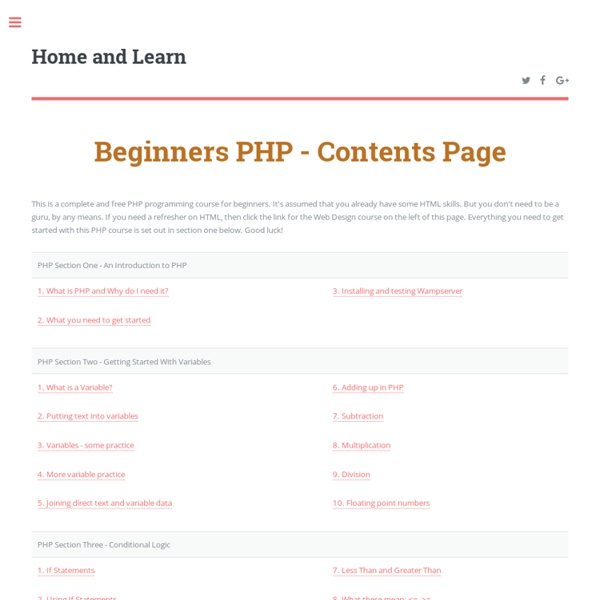



PHP-MySQL free course, online tutorials PHP MySQL code PHP is an open source, server-side web-scripting language that is compatible with all the major web servers (most notably Apache) and databases. By the help of PHP code you can create dynamic website content. Dynamic Web sites are flexible applications than merely sites. • Useful questions and answers on Forum PHP - MySQL. PHP Basic (beginner) PHP Advanced PHP MySQL PHP - MySQLi PDO - MySQL OOP - Classes and Objects PHP DOM: HTML and XML
PHP: Hypertext Preprocessor PHP: The Right Way Learning PHP: Get Started Using PHP This PHP tutorial will guide you through the process of learning and using PHP, preparing you with some fundamental knowledge to get you started in the right path. We will talk about the history of PHP, create a local development environment (so that you won’t need a web server) and create a basic PHP script while discussing common beginner PHP gotchas along the way. Introduction In the beginning, there was nothing. With the introduction of PHP/FI (Personal Homepage Tools) in 1995, everything changed. When Rasmus Lerdorf, the creator of PHP/FI, decided to release the source code of his project, the development went even faster. Andi Gutmans and Zeev Suraski joined the project in 1997 and started working on PHP 3.0 as the official successor of PHP/FI. Shortly after the release, Andi and Zeev were already working on a rewrite of PHP’s core. PHP 4.0, based on the new Zend engine, was officially released in May 2000. What’s PHP? Overview of how PHP works. The Development Environment Junk! <! <!
Learn PHP the easy way - PHPBuddy.com PHP 101: PHP For the Absolute Beginner [box] For a complete list of Zend Training Courses – PLEASE CLICK HERE ! [/box] This area is intended for everyone new to PHP. If you came here to learn about elementary PHP 4 or basic PHP 5, this is for you. PHP 101 (part 1): “Down the Rabbit Hole” An introduction to PHP’s variables and operators.PHP 101 (part 2): “Calling All Operators” The rest of the PHP operators (there are many), and simple form processing.PHP 101 (part 3): Looping The Loop Basic control structures explained.PHP 101 (part 4): The Food Factor Arrays, PHP array functions, and what it all means. The Best Way to Learn PHP Learning something from scratch is almost always an arduous affair -- you simply have no idea as to where to start, or not to start, to kick things off. I loathed learning about the idiosyncrasies of C++'s syntax when all I wanted to learn were some darn programming concepts. As I'm sure you can agree, this is a less than ideal situation. This is where the Nettuts+ "The Best Way to Learn" series comes into the picture. Today, we're going to figure out the best way to learn PHP. Assignment #1: Disregard the Naysayers If you're reading this, chances are that you've Googled a lot to decide which language to learn and how. Haters gonna hate! As the popular saying goes, haters gonna hate! And let's not forget the sheer proliferation of hosts and frameworks PHP has spawned. Assignment #2: Install PHP through [X]AMP You could just install PHP but it gets quite boring without a server and some sort of database to play around with. This is where you grab a package such as XAMPP. Author: David Powers
8 Practices to Secure Your Web App When it comes to application security, in addition to securing your hardware and platform, you also need to write your code securely. This article will explain how to keep your application secure and less vulnerable to hacking. The following are the best habits that a programmer can develop in order to protect his or her application from attack: Input data validationGuarding against XSS attacksGuarding against CSRF attacksPreventing SQL Injection attacksProtecting the file systemProtecting session dataProper error handlingGuarding included files Input Data Validation While designing your application, you should be striving to guard your app against bad input. Always validate data in your PHP code. Guarding Against XSS Attacks Cross-site scripting attack (XSS attack) is an attack based on code injection into vulnerable web pages. Suppose you have a comment form in your application that allows users to enter data, and on successful submission it shows all the comments. Proper Error Handling